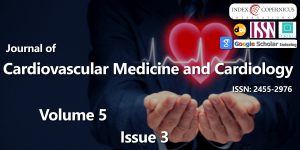Reperfusion of Acute Myocardial Infarction in the elderly (clinical characteristics and prognosis) Results of the IMSS Nuevo León infarction code program
Main Article Content
Abstract
Background: The age is an important prognostic factor in patients with acute myocardial infarction. To find no similar data in the Mexican population, it seeks to establish the characteristics and prognosis of older adults carried out mechanical reperfusion treatment.
Methods and results: We carried out a retrospective analysis included a total of 1025 patients in the program code myocardial reperfusion treatment carried out, being the 15.3 % over the age of 75 years. The age range of 33 to 92 years. The mortality rate is increasing exponentially higher age (3.4 % for patients <= 54 years, 6.1% for 55 to 64 years, 9.2% for 65 to 75 years and 15.9 % for the >= 75 years, p<0,001) in patients older than 75 years, primary angioplasty is the preferred method of reperfusion (77.7 %), without finding in this group of patients, an increase in the cerebral vascular event ischemic or hemorrhagic. Over the age of 75 years who develop cardiogenic shock have a much higher mortality compared with the younger (17.6%, 28%, 33% vs 56%, p<0.001).
Conclusions: Despite the different treatments of reperfusion, mortality remains higher in older adults, mainly by multiple comorbidities and a higher rate of ventricular dysfunction.
Downloads
Article Details
Copyright (c) 2018 Alejandro ZR, et al.

This work is licensed under a Creative Commons Attribution 4.0 International License.
Shanmugam VB, Harper R (2015) An overview of PCI in the very elderly. J Geriatr Cardiol. 12: 174−184. Link: https://goo.gl/cJUkNT
Wang TY, Gutiérrez A, Peterson DE (2011) Percutaneous coronary intervention in the elderly Nat. Rev. Cardiol. 8:79–90. Link: https://goo.gl/SEHBkB
Ibanez B, James S, Agewall S (2017) ESC Guidelines for the management of acute myocardial infarction in patients presenting with ST-segment elevation. European Heart Journal.1–66. Link: https://goo.gl/rPW6PT
Levine GN, Bates ER (2011) ACCF/AHA/SCAI Guideline for Percutaneous Coronary Intervention J Am Coll Cardiol. 58:44–122. Link: https://goo.gl/bhooEM
Campo C, Ferreira RP, Teixeira C (2013) Percutaneous Coronary Intervention using Transradial Access in Elderly vs. Non-Elderly Patients Rev Bras Cardiol Invasiva. 21:36-42. Link: https://goo.gl/WVS5WY
Thiemann DR, Coresh F, Shulman P (2000) Lack of Benefit for Intravenous Thrombolysis in Patients with Myocardial Infarction Who Are Older Than 75 Years. Circulation. 101:2239-2246. Link: https://goo.gl/1ghfmb
Capodanno D, Angiolillo DJ (2010) Antithrombotic Therapy in the Elderly. J Am Coll Cardiol. 56: 1683–92. Link: https://goo.gl/UKf99y
Hsieh V, Jolly SS (2012) Should Radial Access Be the Preferred Approach in the Elderly? Rev Bras Cardiol Invasiva; 20. Link: https://goo.gl/APTMY2
Sim WL, Mutha V (2017) Clinical characteristics and outcomes of octogenarians presenting with ST elevation myocardial infarction in the Australian population. World J Cardiol. 9: 437-441. Link: https://goo.gl/nRttFz
Guagliumi G, Stone GW, Cox DA (2004) Outcome in Elderly Patients Undergoing Primary Coronary Intervention for Acute Myocardial Infarction, Results From the Controlled Abciximab and Device Investigation to Lower Late Angioplasty Complications (CADILLAC) Trial Circulation.110:1598-1604. Link: https://goo.gl/sVs5Fc





